This style box was a Darrow design and Parker Brothers just continued production using his design. Once Parker Brothers figured out Monopoly was taking off, they decided to offer a variety of different game options. One of the first things changed was the color of the box from black to blue. By the end of 1936, all the boxes with this label design were switched to the blue color.
CLICK IMAGES TO ENLARGE
|
BLACK BOX Number 7 GAME 1935-1936
|
1935

TRADE MARK
BLACK BOX
|
The 'Trade Mark' game is the ultimate Parker Brothers Monopoly game for a collector. It is the first to be wholly manufactured by Parker Brothers and is very similar to the Darrow version, except for the addition of player pieces and a redesign of Darrow's black box. It was produced in limited numbers for only a few months in mid-1935. Estimates are that about 24,000 games might have been produced.
The 'Trade Mark' version was also produced in the long box No 9 version. Sorry, no pictures of that one available (yet).
|
1935

PATENT PENDING
BLACK BOX
|
The 'Patent Pending' game was Parker Brothers next version of Monopoly, made after the 'Trade Mark' games. Parker Brothers applied for a patent and added this to the games. By this time, Parker Brothers realised the game was going to be a hit so production was ramped up considerably. It is estimated that over 100,000 'Patent Pending' games could have been made.
No Number 9 White Box games are known with the PATENT PENDING statement on the box.
|
1935
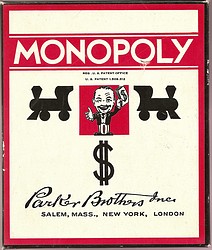
EARLY SINGLE PATENT
BLACK BOX
|
This is the next version. After purchasing rights for Monopoly from Charles Darrow, research discovered another game very similar to Monopoly had been patented in 1924 by Elizabeth Magie. Parker Brothers quickly purchased that patent from Magie and put it on their Monopoly games just to cover their claim to the rights to the game. That patent number 1,509,312 replaced the Patent Pending labels.
This group includes a very few No. 9 white box games where games already printed 'Trade Mark' had this patent added as an overprint. As far as I know, less than a dozen of these game boxes exist today. (VIEW HERE)
|
1936

DUAL PATENT
BLACK BOX
|
On Dec 31, 1935, Parker Brothers was issued a patent for Monopoly, patent 2,026,082. Almost immediately, very early in 1936, this new patent was added to the Magie patent on all Monopoly games, replacing the single Magie patent. These patents also appeared on the several new varieties introduced by Parker Brothers throughout 1936. These patents remained on all Monopoly games until 1941 when the Magie patent expired and was removed.
|
|
BLUE BOX Number 5 & 7 GAME 1936 - 1952
|
1936

DUAL PATENT
COPYRIGHT 1935
|
1936 was a busy year for Parker Brothers and their Monopoly game. They produced 1.8 million copies of the game and introduced several different new versions of the game. The Number 7 game box was changed from black to blue. Also, Parker Brothers was issued their own patent for Monopoly on Dec 31, 1935 and they wanted the world to know about it, so they printed that on these game boxes.
|
1936

DUAL PATENT
COPYRIGHT 1935
A PARKER TRADING GAME
MADE IN USA
|
Late in 1936, Parker Brothers realized that Monopoly was going to be their best seller and drafted a marketing plan to promote the game. Someone came up with the phrase 'A PARKER TRADING GAME' and added that to game boxes late 1936. By early 1937, all Monopoly games included this wording. The words 'MADE IN USA' were added at the bottom of the box.
|
1936

Number 5
DUAL PATENT
REG GREAT BRITAIN & CANADA
Number 5
(For 3 to 8 Players)
|
Another promotional idea was to introduce the Number 5 game, pretty much the same as the Number 7 game, except there were 8 player pieces instead of 7 AND it cost 50c more. They printed these changes on the first Number 5 game boxes. Also, Parker Brothers sold licenses to sell Monopoly to a Canadian and a British company in 1936. They added that bit of information to the legals statement.
|
1936

Number 5
DUAL PATENT
REG GREAT BRITAIN & CANADA
|
Didn't take long for Parker Brothers to realize raising the price of their game in the middle of the Great Depression was a bad idea, so the game went back to $2.00 and the promotional printing was removed, though Monopoly was still their best selling game.
|
1937-1939

DUAL PATENT
LONDON
|
By 1937, the bit about being reg in Great Britain and Canada had been removed and 'A PARKER TRADING GAME' took a prominent position in the legals line and was printed in bold text. This is about the most common variety of 1930s Monopoly.
|
1940

DUAL PATENT
CHICAGO
|
In 1940, Parker Brothers closed their office in London and removed the city from the box. This was replaced by Chicago. This is a very hard to find variety, with Chicago AND the dual patent because the Magie patent (1,509,312) expired in 1941 and had to be removed, so this version was only printed in 1940.
|
1941-1946
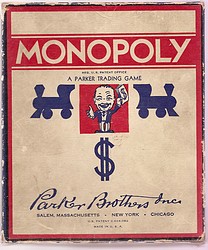
LATE PATENT
REG.
|
In 1941, the Magie patent expired and was removed from the game boxes.
|
1946-1951

LATE PATENT
REGISTERED
|
In 1946, the text 'REG. U.S. PATENT OFFICE' was expanded, thus: 'REGISTERED IN U.S. PATENT OFFICE'.
|
1951-1952

LATE PATENT
"A PARKER TRADING GAME" removed
"PARKER BROTHERS TRADE-MARK NAME FOR IT'S REAL ESTATE TRADING GAME" added
|
In 1951, 'A PARKER TRADING GAME' was replaced with 'PARKER BROTHERS TRADE-MARK NAME FOR IT'S REAL ESTATE TRADING GAME'. As far as I can tell, this was the last version of the Number 7 game. It was discontinued in 1952 and was wholly replaced by the Number 8 Popular Edition as the only small box game being made.
|
~~Canadian~~

|

|
~~Diamond $ Boxes~~
The NEW EDITION game was Parker Brothers first new label design. There are 2 versions of this game, the brown box and black box versions. The brown box version was first, but didn't last very long before Parker Brothers chose to go with the black box version. I believe Parker Brothers found the brown boxes were too hard to come by.
The New Edition games are very hard to find. On Ebay, only 1 in 20 New Edition games are the brown box version, and the matching brown boards are even harder to find. Also, only about 1 in 20 of the games offered with this label say New Edition, the rest say A PARKER TRADING GAME. Conclusion - the black box and board is scarce, the brown box version is very scarce, and the brown New Edition board is rare.
|

NEW EDITION (1936)
BROWN BOX
|

NEW EDITION (1936 - 1937)
BLACK BOX
|
In 1937, Parker Brothers added A PARKER TRADING GAME and the NEW EDITION title was gone.
|

No 6 DUAL PATENT (1937 - 1940)
LONDON
|

No 6 DUAL PATENT (1940 - 1941)
CHICAGO
|

No 6 LATE PATENT (1941 - 1946?)
WOODEN PLAY PIECES
|
Some believe production of this game with the metal player pieces was suspended during WWII and this box, with the metal player pieces removed from the label and wooden play pieces added to the game, was a concession to the shortage of strategic materials/metals. When production of games with metal play pieces resumed after the war, it included a different style cannon than the one pictured on the label, and also a different version of the car.
|
|

No 6 - LATE PATENT (1946)
"REG."
|
After the war, metal for game tokens was available and the old token pictures were once again added to the box tops. Problem was, the molds used to make the cannons were not available and it was replaced with a more modern howitzer style cannon and the shoe was replaced with a cowboy on a rearing horse. The older style car now has a driver, too.
|
|

LATE SINGLE PATENT
(1946 - ??)
"REGISTERED"
|
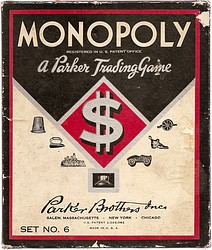
No 6 LATE PATENT (1946 - ??)
MARKED No 6
"REGISTERED"
|
~~POPULAR EDITION~~
Parker Brothers chose to make yet another version of Monopoly, the POPULAR EDITION, game designation Number 8. This was offered along with the Diamond $ boxes and the first Blue Boxes. This version originated with the same small sized boxes as the other 2 types. A lot of thought went into the design of this box. It was made from 1936-1954. The first of these had a green border. In the early 1950s, Parker Brothers added a red border box, as well.
CLICK IMAGES TO ENLARGE
|
SMALL SIZED POPULAR EDITION GREEN & RED BOX
1936-1954
|
1936-1939
 Dual Patent, London
Dual Patent, London
|
This was the first version of the Popular Edition. It had both the Magie (1,509,312) and the Parker Brothers (2,026,082) patents and included London in the list of cities. In addition, it had 'NUMBER 8' game designation was printed on the box, letting folks know this was a different version of Monopoly. This configuration was used until 1940.
|
1940
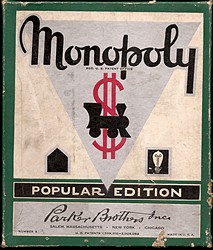 Dual Patent, Chicago
Dual Patent, Chicago
|
In 1940, Parker Brothers dropped London from the list of cities and added Chicago. Not much else was changed.
|
1951-1952
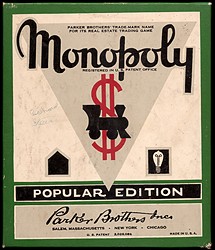
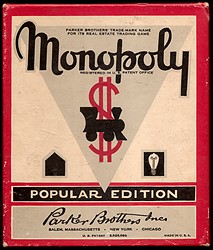 Single patent, Chicago
Single patent, Chicago
|
In 1941, the early Magie patent expired and it was removed from the legal description. Also, the game designation 'NUMBER 8' was removed. In 1949, the REG U.S. PATENT OFFICE statement was changed to REGISTERED IN U.S. PATENT OFFICE. In 1951, 'PARKER BROTHER'S TRADE MARK NAME FOR ITS REAL ESTATE TRADING GAME'. These modifications are present on this box.
Also, in 1951, Parker Brothers introduced a new version of the Popular Edition with a red trimmed box. They were sold along side the green box versions.
|
1953 (1)

 Patent obscured with
Patent obscured with
'moustache'.
|
The Parker Brothers patent (2,026,082) expired on Dec 31, 1952 and they were no longer allowed to use that number on their games, but there was still a significant inventory of box labels already printed up with that number. They decided to reprint a 'moustache' over the expired patent and use them anyway. These are a bit hard to find, though not impossible. The first batch made in 1953 used these labels until they could get the revised labels printed up.
|
1953 (2)
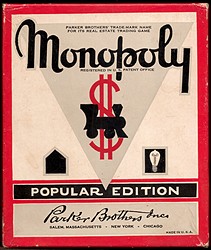 No patent,
No patent,
MADE IN USA on right
|
The second variety for 1953 shows the first printing without the patent and MADE IN USA is still off to the right.
|
1953 (3)

 MADE IN USA centered.
MADE IN USA centered.
|
The third variety for 1953 has MADE IN USA centered, where the patent used to be.
|
1954
 No patent
No patent
San Francisco added.
|
In 1954, San Francisco was added to the list of cities.
|
~~Popular Edition~~

No 8 GREEN BOX
CANADIAN
|
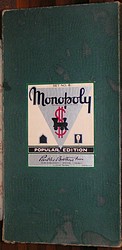
No 8 LONG GREEN BOX (1946)
ALLIGATOR TEXTURE BOX
RARE!
|

No 8 LONG GREEN BOX (1951)
PEBBLE GREEN TEXTURE BOX
RARE!
|

No 8 LONGER GREEN BOX
COPYRIGHT DATE 1954
|
As early as 1936, Parker Brothers had sold licenses to sell Monopoly in other countries. The first were in Great Britain to John Waddington Printing and Canada to the Copp-Clark Company. Then John Waddington sold a license to John Sands in Australia and others. Monopoly became very popular world wide.
Canadian Monopoly games pretty much followed the Parker Brothers game designs, using the same box and board designs, and Atlantic City street names for properties. The British games had completely different game designs and used London street names for properties. Australia used the British game designs and properties.
Below are some early Canadian, British, and Australian game boxes.
Great Britain

GREAT BRITAIN
PRE WWII
|
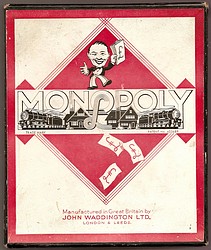
GREAT BRITAIN
WARTIME GAME
|

MONOPOLY NOTE HOLDER
c.1936-1940
|
Australia
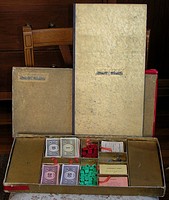
AUSTRALIA
DELUXE GOLD EDITION
1936
Here is a Deluxe Gold Edition Monopoly game from 1936 made in Australia by John Sands Co. This version of Monopoly was also made by Parker Brothers in the U.S., John Waddington in the U.K., Copp-Clark in Canada, and in other countries. Each follows the same general pattern, but each has it's own character, as well. They are all very hard to find.
|

AUSTRALIA
PRE WWII
|
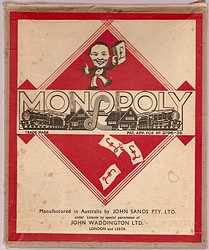
AUSTRALIA WWII GAME
BROWN PAPER SMALL BOX
|

AUSTRALIA PRE WWII GAME
WHITE SMALL BOX
|
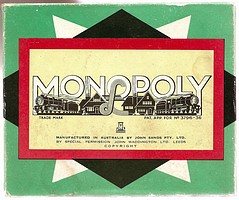
AUSTRALIA 1950's POPULAR EDITION
SMALL GREEN BOX
|

AUSTRALIA WWII LONG BOX
PLAIN CARDBOARD BOX
|
No 9 WHITE BOX
TRADE MARK with MAGIE PATENT - 1935
RARE!

|
|

|
|
No 9 WHITE BOX
DUAL PATENT - CHICAGO (1940 - 1941)

|
|

|
|
|
CANADIAN WHITE BOX MONOPOLY GAME
PATENT APPLIED FOR
c. 1936
|
|
Parker Brothers sold a license to manufacture and sell Monopoly games in Canada to Copp-Clark in late February, 1936. Copp-Clark immediately applied for a Canadian patent for the game. In November, 1936, the Canadian patent for Monopoly was approved. After that time, games were labeled with the Canadian patent 362,124.
However, described here is an even earlier Canadian form of Monopoly in the white box. Shows CANADIAN PATENT APPLIED FOR and CANADIAN (Trademark) REGISTRATION APPLIED FOR on the game box, instructions, and game board, with reference to the early Parker Brothers dual American patents. This game with these legals is highly collectible!
PLEASE NOTE: I saw another White Box Canadian Monopoly game offered on Ebay recently with Patent Applied For on the game board. The rest of the game parts had the usual Canadian patent and registration numbers.
|
| |
|
|




























